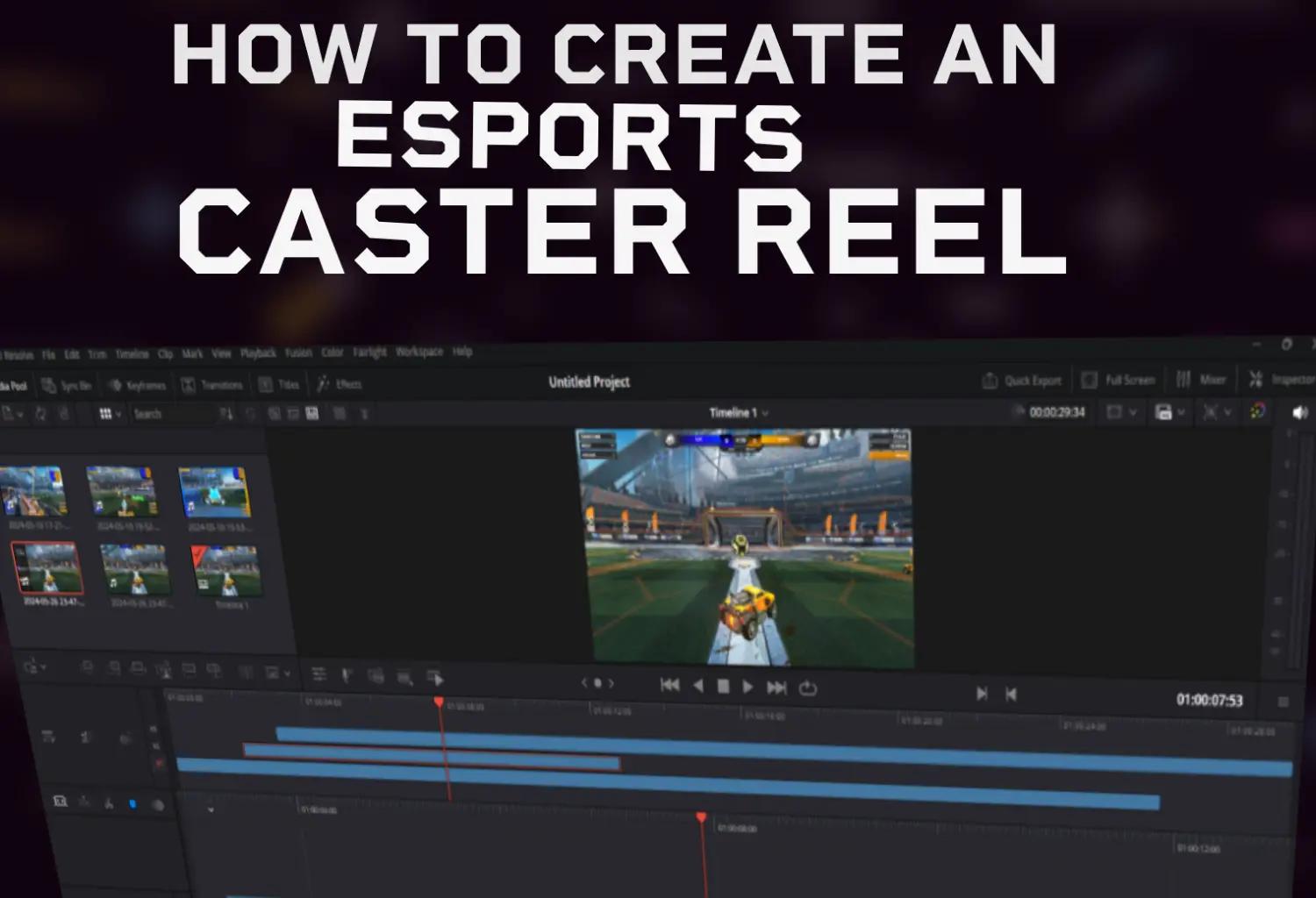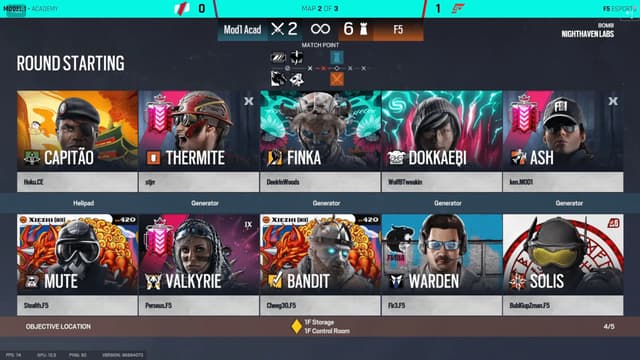Creating an Esports Caster Reel
Creating an effective caster reel is crucial for showcasing your talents and landing opportunities in the exciting world of esports commentary. A well-crafted reel not only highlights your commentary skills but also demonstrates your personality, professionalism, and ability to engage an audience.
This guide will walk you through the key elements of a great caster reel that will capture the attention of potential employers and event organizers.
1. Optimal Reel Structure
First 30 Seconds: Make Them Count
- Start with a friendly intro featuring you and, if applicable, a co-caster to establish a personal connection.
- Immediately transition into high-energy, exciting commentary to showcase your ability to captivate an audience.
- Keeping the energy up early in the video is key to a great reel.
- Showcase your best work upfront to hook the viewer and set the tone for the rest of the reel.
- We want to assure our viewer's attention is grabbed immediately so they do not scroll forward
Overall Duration
- Aim for 1:30-2:20 minutes total to keep the reel concise yet comprehensive.
- This length provides enough time to demonstrate your skills without losing viewer interest.
- It also ensures compatibility for posting on platforms like Twitter/X, which have strict video length restrictions (typically under 2:20 for standard uploads).
Montage Approach
- Consider structuring your reel as a montage of your best moments, interspersed with brief on-camera segments to maintain a dynamic pace.
- Try to utilize smooth transitions to create a cohesive narrative that flows naturally.
2. Essential Elements to Include
| Element | Description | Importance |
|---|---|---|
| Intro | Brief self-introduction with your name, role, and contact info (e.g., Twitter/X handle, email) | ★★★★★ |
| High-energy moments | Showcase your ability to hype up exciting plays, such as clutch moments or game-changing plays | ★★★★★ |
| Calm moments | Demonstrate your versatility by including analytical or narrative commentary during quieter game phases | ★★★★☆ |
| Co-caster interactions | Show how well you collaborate, share mic time, and complement your co-caster's style | ★★★★★ |
| On-camera presence | Display your professionalism, charisma, and comfort in front of the camera | ★★★★☆ |
| Clip variety | Include different games, events, and energy levels to show your range and adaptability | ★★★★★ |
| Character moments | Highlight your unique personality, catchphrases, or memorable moments that make you stand out | ★★★★☆ |
| Outro or ad reads | Showcase your ability to deliver professional outros or promotional content smoothly | ★★★☆☆ |
| Storytelling | Weave a narrative through your clips to show your ability to guide viewers through a match | ★★★★☆ |
Tips for Essential Elements
- Intro: Keep the intro concise (5-10 seconds), including your name and a quick tagline (e.g., "Esports commentator specializing in FPS games").
- High-energy moments: Choose clips with intense gameplay or crowd reactions to amplify excitement.
- Calm moments: Include analytical breakdowns or storytelling to showcase your ability and depth in your commentary.
- Clip variety: If possible, feature at least 2-3 different games or events to demonstrate versatility.
3. Clip Selection and Editing
Clip Duration
- Keep individual clips short and impactful, ideally 10-20 seconds, to maintain viewer engagement.
- Avoid overly long clips that may dilute the energy of the reel causing the viewer to skip ahead.
Clip Variety
- Include clips from different events and game matchups to show your adaptability across various esports titles and settings.
- Showcase a range of casting scenarios, such as:
- Early-game analysis to demonstrate strategic insight.
- Teamfights or high-action moments to highlight energy and excitement.
- Game-ending moments to show how you wrap up a match.
Clip Cohesion
- Organize clips to create a flow of rising energy and excitement, starting strong and building to a climactic moment.
- Use on-camera clips as transitions between gameplay segments to maintain viewer interest and add a personal touch.
- Avoid jarring cuts by ensuring smooth audio and visual transitions between clips.
Editing Tools
- Use professional editing software like DaVinci Resolve or Final Cut Pro for clean cuts and transitions.
- Free alternatives like CapCut can work for beginners but may have limitations.
4. Technical Considerations
Audio Quality
- Ensure your voice is clear and easily audible by using a high-quality microphone (e.g., condenser or dynamic mics like the Shure SM7B or Audio-Technica AT2020).
- Attempt to Balance your audio with game sounds and co-caster volume to avoid drowning out key elements.
Video Quality
- Use high-resolution footage (1080p minimum) to ensure a professional look.
- Ensure smooth frame rates (at least 60 FPS for gameplay clips) to avoid choppy visuals.
File Format
- Export your reel in MP4 format with H.264 codec for compatibility across platforms.
- Keep file size reasonable (under 100 MB) for easy sharing on platforms like Twitter/X or YouTube.
5. Showcasing Co-Casting Skills
- Include clips that demonstrate smooth handoffs and pickups with co-casters to show teamwork and communication.
- Show your ability to share mic time effectively, avoiding talking over your co-caster or leaving awkward silences.
- Highlight moments where you complement your co-caster's style, such as adding humor to their analysis or building on their commentary.
- Include at least 2-3 clips featuring co-casting to demonstrate your ability to work in a duo or team setting.
Example Scenarios
- A moment where you seamlessly pick up after your co-caster's play-by-play with insightful analysis.
- A humorous or engaging back-and-forth that showcases chemistry.
- A synchronized hype moment where both casters amplify the excitement of a play.
6. Final Touches
Intro and Outro
- Create a professional, branded intro and outro using either animated contents or a static image which can be created using PhotoPea for example.
- Include your contact information (e.g., Twitter/X handle, email, Discord) and social media handles in the outro for easy access.
- Consider adding a logo or personal brand graphic to make your reel memorable.
Background Music
- Choose appropriate background music that enhances but doesn't overpower your commentary. Look for royalty-free tracks on platforms like StreamBeats or Bensound.
- Keep music volume low (around 20-30% of commentary volume) to maintain focus on your voice.
7. Review and Refine
Before finalizing your reel, ask yourself these questions:
- Does the first 30 seconds grab attention? Ensure the opening is dynamic and engaging.
- Is there a good balance of high-energy and calm moments? Verify that you showcase versatility.
- Are your co-casting skills adequately demonstrated? Confirm that teamwork is evident.
- Is the audio clear and well-balanced throughout? Double-check for audio issues.
- Does the reel showcase your unique personality and style? Ensure your individuality shines through.
- Is the pacing consistent? Avoid overly long segments that may cause viewers to lose interest.
Feedback Loop
- Share your drafted reel with trusted peers, or other casters for constructive feedback.
- Submit your reel to the over to BroadcastGG Discord for professional feedback from industry experts and fellow esports commentators
- Revise based on feedback to polish the reel further.
- Consider updating your reel every 6-12 months.
8. Distribution and Promotion
- Upload to multiple platforms:
- Twitter/X: Share your reel as a pinned post with a brief caption highlighting your skills.
- YouTube: Upload with a detailed description and relevant tags (e.g., #esportscasting, #casterreel).
- Portfolio website: Embed the reel on a personal website or portfolio for professional inquiries.
9. Common Mistakes to Avoid
- Overloading with clips: Too many clips can make the reel feel chaotic. Stick to 6-10 high-quality clips.
- Poor audio quality: Muffled or unbalanced audio can ruin an otherwise great reel. Invest in good audio equipment.
- Lack of personality: Failing to show your unique style may make your reel forgettable.
- Ignoring platform requirements: Ensure your reel meets the technical specs for platforms like Twitter/X (e.g., 2:20 max length, MP4 format).
- Outdated content: Avoid using clips older than 1-2 years unless they're exceptionally high energy or still relevant.
10. Additional Tips for Success
- Study successful casters: Watch reels from top casters (e.g., @HaughtSauce, @The_Llama77) to understand pacing, energy, and structure.
- Practice regularly: Continue casting in smaller events, streams, or community tournaments to generate fresh content.
- Build a personal brand: Develop a consistent online presence (e.g., Twitter/X, Twitch) to complement your reel and attract opportunities.
Remember, your caster reel is often your first impression in the esports industry. A polished, professional reel that showcases your skills, personality, and versatility can open doors to exciting opportunities.
Take the time to refine and perfect it, and don't be afraid to update it regularly with your best recent work.



